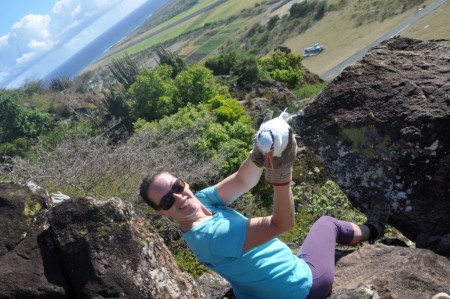
Back in 2005, I first visited St. Eustatius on vacation. I was living in Amsterdam at the time and thought I’d give one of the lesser known Dutch Caribbean islands a try. Vacation turned into a ‘year off’ when I decided to return to the island in 2006, and that year off has since turned into a career in ecology, a house, a partner, and a child in 2016. The island has a way of grabbing hold of your heart—I had fallen in love with the way of life here, unhurried and unspoiled, and also the island’s inhabitants—namely its Red-billed Tropicbirds.
St. Eustatius, affectionately known as Statia, is a small landmass with a big history. Famous (but not well known) for being the first foreign nation to recognize the United States of America’s long sought-after independence in 1776, the island reached its economic peak around 1795. Each year, thousands of ships anchored on the roadstead of Oranjestad, and the shore of the Bay was lined with hundreds of warehouses packed with goods. In fact, more trade (both legal and illegal) transpired here after the end of the American Revolution than on any other Caribbean island.
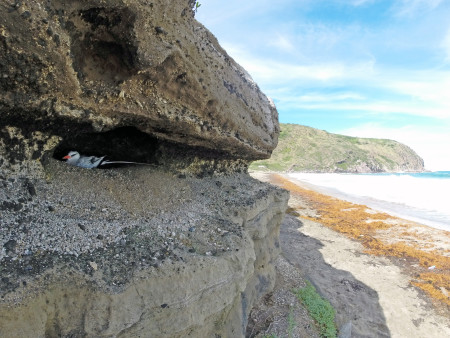
But we are here to talk about birds, seabirds specifically. As the eighteenth century drew to a close, St. Eustatius gradually lost its importance as a trading center and most merchants and planters left the island. Through the nineteenth and twentieth centuries, Statia became and remained a quiet island. In contrast to the rapid and excessive environmental destruction that has ravaged many Caribbean islands in their quest for economic development, the coastlines of Statia have remained untouched by high-rise hotels or boardwalks. This means that, despite its small size, the island has become one of the main nesting sites for Red-billed Tropicbirds in the region (Saba and Little Tobago being the others).
In 2012 I participated in a tropicbird monitoring workshop on Statia, led by Dr. Adrian Delnevo and facilitated by the Dutch Caribbean Nature Alliance. That same year I also attended an international training workshop for seabird research and conservation on San Salvador, the Bahamas, organized by BirdsCaribbean, Clemson University and Defenders of Wildlife. It was then that I realized the increasing vulnerability of seabirds and the importance of better understanding their threats and population dynamics. I also learned field techniques for monitoring and studying seabirds in these workshops. So, in 2012, together with former intern Andrew Ellis, and employed by STENAPA, the local conservation NGO, we embarked on a mammoth quest to find the island’s main nesting sites. We initially only knew that tropicbirds nested along Zeelandia Beach, which faces the Atlantic Ocean, because we could see them inside crevices in the cliff face. But where else did they nest?
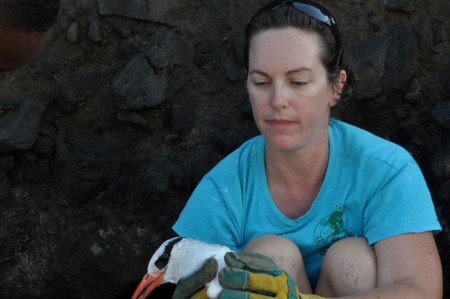
According to earlier published literature, there were estimated to be only 30 pairs of Red-billed Tropicbirds on Statia (Lee and McGehee, 2000). This was followed by EPIC’s estimate of 100-200 pairs in 2003. Having traversed the entire island in search of nests during 2012-2013, however, we believe the population more likely totals around 300-500 pairs. To our surprise, the main nesting site was not Zeelandia Beach – in fact we realized this was one of the worst habitats for tropicbirds due to erosion of the sandstone cliff. After clambering over giant boulders along Statia’s north-west coast, we finally hit gold. At elevations of just 20-40 meters above sea level, we were able to (safely) access some 85 nests along a narrow strip of coastline spanning approximately 1km. While there are many more nests at higher elevations, our lack of levitation prowess prevented us from accessing those.
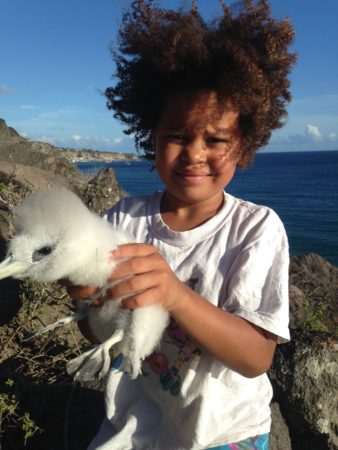
And so, since 2012, from mid-October to mid-May, we have faithfully monitored this magnificent seabird. We measure, weigh and band adults and chicks and record nest success. Sticking your hand into the nest of a ferociously angry and defensive tropicbird’s nest may not sound like fun to some, but I like to think my family would be proud. I have become accustomed to the joys of regurgitated fish, pooped-on pants, and new scars after every visit. When my daughter comes home from school I show her my new collection of scrapes and bites. She has even joined me on fieldwork (see photo) and is now the go-to person at school for anything nature-related.
Since 2012 we have banded about 450 tropicbirds. We’ve also attached geolocators and GPS loggers to a few individuals, with varying rates of retrieval success. We have learned that they can travel great distances inside and outside the breeding season, and we now have a better understanding of the threats they face (mainly rats, which prey on eggs and young), but this is just the beginning. As I write this, we are submitting a proposal to further study Red-billed Tropicbirds on Statia and Saba. If approved, I will spend another four years doing my PhD on this enigmatic species. Being able to contribute to regional knowledge and the long-term conservation of this beautiful bird is a worthy endeavor and well worth the battle scars. I am grateful for the exciting opportunities that have allowed me to stay on Statia and study Red-billed Tropicbirds; hopefully my Caribbean seabird journey will continue – stay tuned!
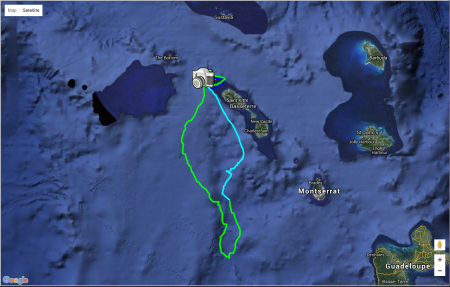
By Hannah Madden, Terrestrial Ecologist, Ecological Professionals Foundation, St. Eustatius

Most exciting to read about this work! Can you tell me the seasonality of this population? That is, when do they lay eggs and raise chicks? Are they mostly synchronous, or is laying spread over a wide period? I have looked for active nests on Barbuda in March and June without success, though local folks say they definitely nest there.
I have studied both the other species of tropicbird in the Indian Ocean and would be very interested to see how this species compares.
I love Tropicbirds! It would love to have had gps and geolocators back in the mid 1980’s. it would have been a lot cheaper and more productive than the Cessna-182 and radio tags we used back then on White-tailed Tropicbirds. Some flew out over Vieques and we could nor fly into that airspace then. We had very few Red-billed at that colony.
Many of us can relate Fred!!! Technology for research has come a long ways – how fortunate we are to have these new tools which are providing exciting answers to important questions about bird movements and habitat use. Best, Lisa Sorenson
Hi Hannah,
Back in 2002/3 my friend and I raised three chicks, which were nearly dead. They all grew into healthy birds and were released at Zeelandia beach at the time.
Whenever I have to leave Statia, I think of their call. I love them!
Thanks for sharing Chermette, how wonderful that you had this experience to raise 3 tropicbird chicks and released them back to the wild! I have been fortunate to see tropicbirds on Zeelandia Beach with Hannah – they are spectacular birds! Hope to meet you some time in Statia. all the best, Lisa Sorenson